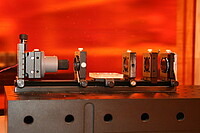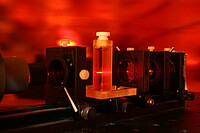Relaxation Spectroscopy
Iron oxide nanoparticles are used as tracers for Magnetic Particle Imaging. Besides the spatial bio-distribution the image quality of the magnetic particle imaging concept is determined by the particle’s diameter as well. The synthesis of nanoparticles produces a solution which contains particles of many different sizes. In order to establish good spatial resolution and high recording speed, it is thus necessary to objectively evaluate the size separation of the nanoparticles. This can be done using the relaxation characteristics of the particles. While the Brownian motion affects the whole particle and thus allows the determination of the hydrodynamic radius, the Néel relaxation affects only the core and thus allows the determination of the core diameter of the particle.
Considering the Brownian relaxation and the Cotton-Mouton effect, a spectrometer was constructed to measure the average hydrodynamic particle radius of superparamagnetic iron oxide nanoparticles in aqueous solution. Measurements can be realized in only a few minutes and thus offer a simple alternative to measurements with Photon Cross Correlation Spectroscopy (PCCS).


Relaxation spectroscopy at the Institute of Medical Engineering.
Publications
-
Evaluation of a Cotton-Mouton Relaxometer for the Characterization of Superparamagnetic Iron Oxide Nanoparticles, 2015, DOI: 10.1109/IWMPI.2015.7107058.
-
A Cotton-Mouton Spectrometer with Optimized Field Cancellation Using n-MOSFET-Based Current Switching, 2014, DOI: 10.1515/bmt-2014-5009.
-
Construction of a Spectrometer to Measure the Cotton-Mouton Effect of Superparamagnetic Iron Oxide Nanoparticles, 2013, DOI: 10.1515/bmt-2013-4102.




